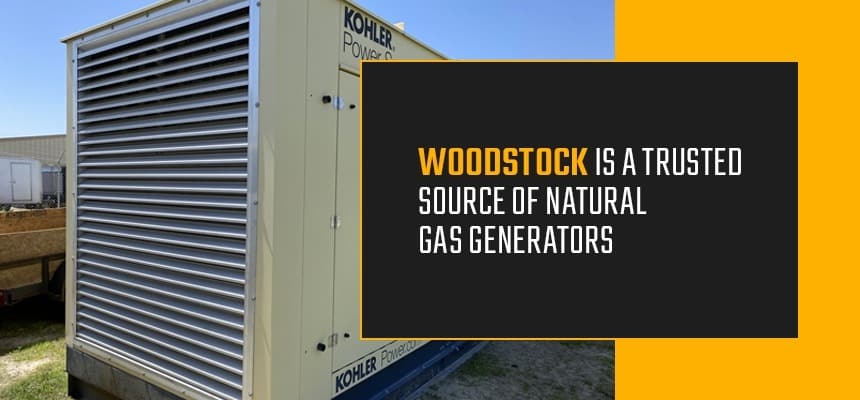How Does a Natural Gas Generator Work?

If you run a commercial or industrial facility, you know the importance of keeping a standby generator on hand. Power outages happen, and you want to ensure you always have a backup plan so you can continue to conduct crucial business operations.
A new or gently used standby generator is a worthwhile investment for businesses in any industry. When deciding what type of model is best for you, natural gas-powered generators have many benefits to offer. The first step to deciding on a natural gas-fired generator is understanding how they work and how using this type of fuel can be useful for you.
Parts of a Natural Gas Generator
Natural gas generators include many moving parts that, when working together, produce the electricity you need to power your business’s essential appliances and operations. The main components are:
- Fuel: First and foremost, natural gas power generators need fuel to get them running. You can easily acquire a fuel supply by tapping into your municipality’s existing natural gas pipeline. Drawing fuel from a townwide source ensures your generator will maintain a steady fuel supply, meaning you can keep your operations going with minimal interruptions.
- Combustion chamber: Natural gas generators’ internal combustion engines contain a combustion chamber, an enclosed space where a mixture of air and fuel is compressed and then burned.
- Pistons: Pistons are parts of the engine that slide back and forth within the combustion chamber, making the space inside bigger or smaller to compress the air and fuel to increase its combustibility.
- Spark plugs: Spark plugs are small pieces with electrodes on the ends that protrude into the combustion chamber.
- Crankshaft: The crankshaft is a piece attached to the pistons that converts the up-and-down motions of the pistons into a rotating motion. This motion spins the rotor inside the stator to create electricity.
- Stator: The stator is a series of insulated wire coils that create a stationary cylinder around the rotor.
- Rotor: The rotor is the rotating electromagnetic shaft inside the stator that helps create the powerful electrical current.
Browse Used Natural Gas Generators
How a Natural Gas Generator Works
Generators harness mechanical energy, fueled by natural gas in this case, to create electricity. Natural gas generators use fuels such as propane or natural gas, drawn either from a direct line piped in by utility suppliers or via a tank, to generate the cleanest fossil fuel electricity possible.
Natural gas-powered generators provide energy for other appliances through the following steps:
- Injection: The internal combustion engine injects fuel and air into the combustion chamber, where the mixture gets compressed by the piston.
- Ignition: After the piston compresses the air and fuel combination, the spark plug ignites the fuel with a small but powerful spark. The spark ignites an explosion in the chamber that the rest of the generator turns into mechanical energy.
- Electricity generation: Ignition causes the gases to expand, pushing the piston down with enough force to turn the crankshaft, which then spins the rotor. When the rotor spins, the stator wires conduct electricity and combine into a single large electrical current that, if large enough, can power appliances and buildings.
Benefits of Natural Gas Generators
Investing in an industrial generator means having a machine you know you can trust when the power grid goes dark. Some of the biggest benefits of natural gas generators include:
- Generally low cost: Natural gas generators usually have lower upfront costs than comparable diesel generators when considering larger power rating requirements. Natural gas fuel also typically costs less than diesel fuel, meaning your long-term operating costs can remain low for the duration of your generator’s life.
- High fuel supply: Rather than having to refill a fuel tank repeatedly, you can connect a natural gas generator to your local gas pipeline for a near-unlimited fuel supply you can rely on, barring any major disasters or utility failures. Diesel generators require extra time and expense to polish the fuel to remove contaminants. While diesel’s limited shelf life in storage means it requires extra planning and expense, with natural gas, you’re able to simply tap into the local supply.
- Low emissions: Natural gas is one of the cleanest-burning fossil fuels, releasing fewer toxins into the atmosphere than other generator fuels.
- Quiet running sounds: Natural gas generators run more quietly than their diesel counterparts, making them ideal for applications where you would house them in a generator room or an area with a noise ordinance in place.

Why Choose a Used Natural Gas Generator?
When you’re in the market for an industrial generator, a used model might check off every item on your list. Choosing a used natural gas generator has many benefits, including:
- Convenience: If your facility already receives natural gas, installing a natural gas generator is easily done. When gas is piped directly to the generator, you don’t need to worry about checking fuel tank levels or providing fuel yourself.
- Environmental impact: Buying secondhand generators is a great way to give new life to gently used, refurbished units and produce less waste.
- Cost: Opting for a used model is a smart way to save on your investment. Used appliance retailers often sell their generators at significant discounts, so you can save up to 70% of what a new model would have cost you.
What Is the Best Natural Gas Generator for My Needs?
Once you’ve decided to go the natural gas route, you’ll need to find the best generator for your business. Consider the following specifications as you evaluate your options to determine the most effective natural gas generator for you:
- Emissions rating: The U.S. Environmental Protection Agency implements a series of guidelines and regulations to reduce harmful emissions polluting the environment. Each phase of regulations over the past few decades has become stricter to help curb the environmental effects of new generators. Different types of generators must adhere to different ratings, so as you search for the best model, make sure it fits the most updated EPA criteria. If you reside in a state on the West Coast, namely California, be sure to focus on natural gas generators that are CARB certified.
- Phases: Generators come in two types—single-phase and 3-phase. While both use alternating current (AC) electricity, single-phase models produce one AC flow, while 3-phase models produce three oscillating flows for stronger and more continuous power output.
- Size: It’s essential to consider generator size to ensure you have the correct amount of power. Overloading a generator that’s too small for your applications can damage the generator and the attached appliances and even cause a fire.
- Sound enclosure: While natural gas generators run more quietly than other types, you may still want or need to create a quieter environment and avoid constant exposure to generator sounds, which can damage people’s hearing. Sound-attenuated enclosures help mitigate this issue by surrounding the generator to reduce its noise output. If you want to install a generator in an area that needs to stay quiet, a sound enclosure is the solution for you.
Sizing a Natural Gas Generator
When determining the size you need for your natural gas generator, aiming for machine efficiency is key. Units that are too large can waste energy, while units that are too small can quickly become overloaded. The size you choose will relate to other generator considerations, such as:
- Function: Think about why you need the generator and how often you’ll use it. Determine what appliances you’ll absolutely need to keep running during an outage and look at generators that can handle that load.
- Fuel supply: Investigate any natural gas fuel supply limitations at your location. If your facility can only supply a limited amount of gas at a time, go for a generator that requires less fuel.
- Generator room: The generator machine itself will need to fit in your facility. Use how much space you have for a generator to help you narrow down your size choices. Additionally, you’ll need to follow certain generator room regulations to ensure safe operation depending on generator voltage.
For help determining your ideal natural gas generator’s size, count on Woodstock Power Company to help you meet your needs.
Considerations for Natural Gas Installation
Installing a natural gas-powered generator for electricity is an investment in your company’s future success. To ensure you reap all the benefits of this environmentally friendly, energy-efficient solution, be sure you’re prepared for any challenges, including:
- Fuel supply issues: Attaching to your local natural gas pipeline means you’ll usually have a steady supply of fuel. However, events such as natural disasters and severe temperatures can put a strain on natural gas resources as many businesses and households in your area compete for the same means of powering their spaces. During periods of high demand, areas may not have enough pipelines to distribute gas to all who need it. Plan ahead for fuel shortages by creating space in your budget to ensure you have access to the fuel you need and can afford any rising prices. The cost of natural gas may also fluctuate at certain periods throughout the year, causing the cost to operate the generator to increase. This can affect the overall cost of using a natural gas generator.
- Location: Make sure the area where you’re installing your generator can accommodate your ideal fuel levels. While some areas in the U.S., such as Texas and North Dakota, have an abundance of natural gas, many areas in the northeast encounter seasonal gas shortages. If you’re looking to install a natural gas generator in a location prone to shortages or natural disasters, make a backup plan so you’re always prepared.
- Maintenance needs: Natural gas generators require more maintenance than diesel generators, meaning you may need to pay higher service costs over a shorter period of time. This is due to the spark ignition that comes standard on natural gas generators. If you would still like to reap the benefits of a natural gas model, factor in regular maintenance around scheduled downtime so you can get back to work as soon as possible.
Woodstock Is a Trusted Source of Natural Gas Generators
Generators are an ideal energy solution for a variety of industries. When you install a natural gas generator, you can be confident in your choice of a clean-burning machine that will keep your operations running until you can connect back to the power grid.
For premium service, including knowledgeable customer service representatives available for advice and to help walk you through the sales process, trust Woodstock Power Company. We provide the best in commercial and industrial generator sales, including buying and selling used generators at great rates. We also provide additional services that go hand-in-hand with generator sales, such as tune-ups and power accessory rentals.
Get in touch today for generator information and more! You can also call us 24/7 at 610-658-3242 to speak to a Woodstock representative.
Follow us on LinkedIn, YouTube, Facebook, and Twitter for more info about commercial generators!


